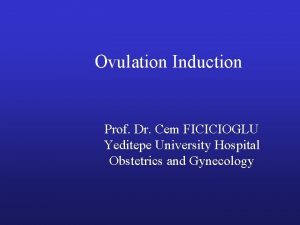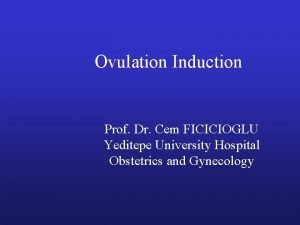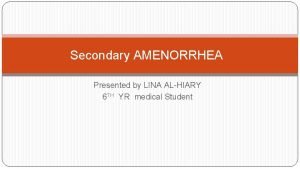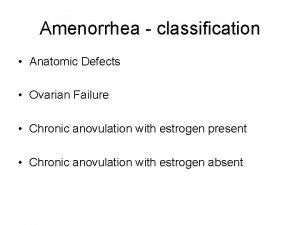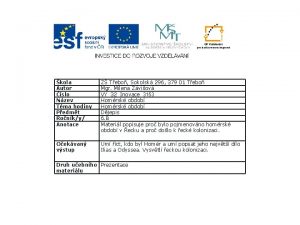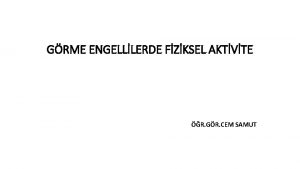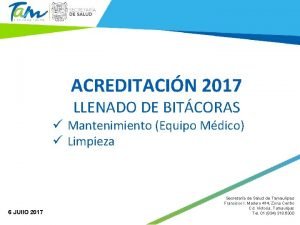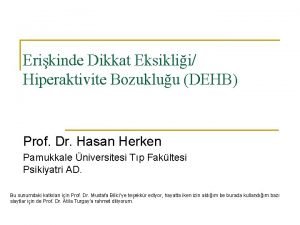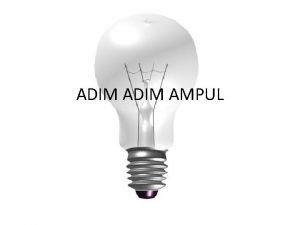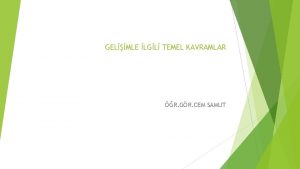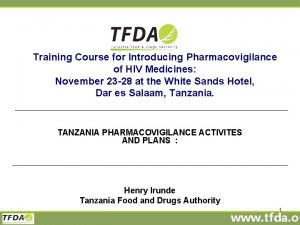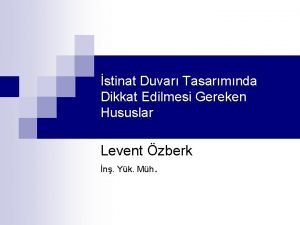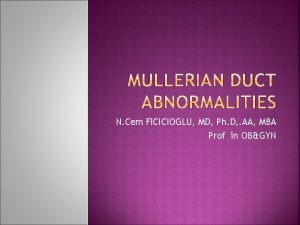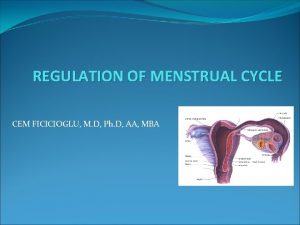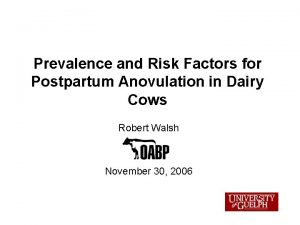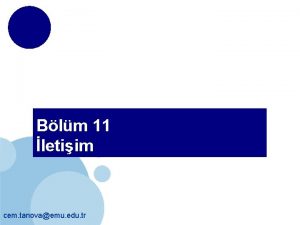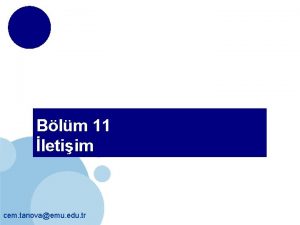ANOVULATION CEM FICICIOGLU M D Ph D AA





























- Slides: 29

ANOVULATION CEM FICICIOGLU, M. D, Ph. D. , AA. , MBA


Central defect Anormal feedback signals Local ovarian conditions Obesity


Central defect Emotional Nutritional (weight loss, eating disorders) Physical stress (excessive exercise) Pituitary tumors Hyperprolactinemia Anormal gonadotropin secretory dynamics


Anormal feedback signals Chronically elevated estrogen concentration Failure of the LH surge

• Local ovarian conditions

Obesity 1. Increased peripheral aromatization of androgens, resulting in chronically elevated estrogen concentrations. 2. Decreased levels of hepatic SHBG production, resulting in increased circulating concentrations of free estradiol and testosterone. 3. Insulin resistance, leading to a compensatory increase in insulin levels that stimulates androgen production in the ovarian stroma, resulting in high local androgen concentrations that impair follicular development

Defining the Cause of Anovulation Ovarian failure. Hypergonadotropic hypogonadism Central defects. Hypogonadotropic hypogonadism Hypothalamic-pituitary-ovarian dysfunction

PCOS The most obvious and common condition associated with chronic anovulation 4– 6% of reproductive age women PCOS does not cause anovulation; rather, PCOS is the consequence of chronic anovulation

PCOSPATHOPHYSİOLOGY PCOS is a complex disorder, similar to cardiovascular disease and type 2 diabetes mellitus, wherein numerous genetic variants and environmental factors interact, combine, and contribute to the pathophysiology

PCOS- PATHOPHYSİOLOGY

PCOS- PATHOPHYSİOLOGY İncreased serum LH concentrations Low-normal FSH levels Increased LH: FSH ratios Chronically elevated estrone concentrations (derived from peripheral aromatization of increased androstenedione) Normal or modestly increased levels of inhibin B (derived from small follicles) Increased ovarian androgen production Increased circulating insulin levels

PCOS- PATHOPHYSİOLOGY Insulin resistance is a common feature in obese and, to a lesser extent, lean women with PCOS The overall prevalence ranges between 50% and 75% Up to 35% of women with PCOS exhibit impaired glucose tolerance 7– 10% meet criteria for type 2 diabetes mellitus

PCOS- PATHOPHYSİOLOGY Increased circulating insulin levels Increased ovarian androgen production Inhibiting hepatic SHBG production Hyperandrogenism

PCOS- PATHOPHYSİOLOGY

PCOS- PATHOPHYSİOLOGY

PCOS- PATHOPHYSİOLOGY Insulin resistance and hyperinsulinemia are undoubtedly an important part of the pathophysiology of PCOS Insulin resistance and hyperinsulinemia are not the primary cause or pathogenic factor in all women with PCOS 25– 50% of women with PCOS have no demonstrable insulin resistance

PCOS- PATHOPHYSİOLOGY Obesity relates primarily to genetic and environmental factors and is a common, but not essential, feature of PCOS Obesity contributes modestly to the risk for developing PCOS and adds to the pathophysiology in already affected women byaggravating the degree of insulin resistance and hyperinsulinemia

PCOS- PATHOPHYSİOLOGY Increased LH stimulation + hyperinsulinemia + obesity Hyperandrogenism is the key feature of PCOS

PCOS- PATHOPHYSİOLOGY

PCOS- DİAGNOSİS ESHRE-ASRM, Rotterdam, 2003; at least two of three major criteria: (1) oligo/anovulation (2) clinical or biochemical signs of hyperandrogenism (3) polycystic ovaries (as identifi ed by ultrasonography), also excluding other androgen excess disorders

PCOS- DİAGNOSİS AE-PCOS, 2006: (1) hyperandrogenism (hirsutism and/or hyperandrogenemia) (2) ovarian dysfunction (oligo/anovulation and/or polycystic ovaries) (3) exclusion of other androgen excess or related disorders

PCOS- DİAGNOSİS Evaluation of women with suspected polycystic ovary syndrome should include: 1. Serum thyroid-stimulating hormone (TSH) 2. Serum prolactin 3. 2 -hour oral glucose tolerance test 4. Fasting lipid profi le 5. Endometrial sampling (in women whose history indicates potential long -term exposure to unopposed estrogen stimulation) 6. Serum testosterone (in women with moderate or severe hirsutism) 7. Morning follicular phase serum 17 -hydroxyprogesterone (in women with a pre- or perimenarcheal onset of hirsutism, a family history of congenital adrenal hyperplasia, or high-risk ethnicity) 8. Overnight dexamethasone suppression test (in women with signs or symptoms of hypercortisolism)

EXCLUSION OF OTHER ANDROGEN EXCESS DISORDERS Thyroid Disorders Hyperprolactinemia Nonclassical Congenital Adrenal Hyperplasia Androgen-Secreting Ovarian and Adrenal Tumors Severe Insulin Resistance Syndromes Cushing Syndrome Idiopathic Hirsutism

EXCLUSION OF OTHER ANDROGEN EXCESS DISORDERS

PCOS- CLİNİCAL MANAGEMENT The management of women with PCOS should seek to correct or prevent both its immediate and longer-term clinical consequences, which may include all of the following: ● Menstrual abnormalities. ● Increased risk for developing endometrial hyperplasia and neoplasia. ● Hyperandrogenism (hirsutism, acne, alopecia). ● Infertility. ● Increased risk for developing type 2 diabetes. ● Increased risk for developing cardiovascular disease

PCOS- CLİNİCAL MANAGEMENT Estrogen-progestin contraceptives Cyclic or continuous treatment with progestins alone Insulin sensitizing agents (metformin, thiazolidinediones) Cosmetic measures (shaving, plucking, waxing, depilatories) Antiandrogens (e. g. , spironolactone, cyproterone acetate, flutamide).
 Raloxiphene
Raloxiphene Prof. dr. cem ficicioglu
Prof. dr. cem ficicioglu Oligomenorrhea and amenorrhea
Oligomenorrhea and amenorrhea Anovulation who classification
Anovulation who classification Anovulation who classification
Anovulation who classification O čem vypráví odyssea
O čem vypráví odyssea Cem yurtsev
Cem yurtsev Cem samut
Cem samut Kesecik ve tulumcuk
Kesecik ve tulumcuk Llenado de bitacoras
Llenado de bitacoras Musahiplik
Musahiplik Cem yurtsev
Cem yurtsev Cem turan bilgisayar mühendisi
Cem turan bilgisayar mühendisi Uvaha
Uvaha Cem flow
Cem flow Certified in exhibition management
Certified in exhibition management Cem yurtsev
Cem yurtsev Perinatal anoksiya
Perinatal anoksiya Cem programming language
Cem programming language Cem samut
Cem samut Cem yurtsev
Cem yurtsev Cem yurtsev
Cem yurtsev Cem yurtsev
Cem yurtsev Iris tabakası
Iris tabakası Cem samut
Cem samut Cem stands for in pharmacovigilance
Cem stands for in pharmacovigilance Na čem závisí podnebí
Na čem závisí podnebí Betonarme
Betonarme Cem arslan arge
Cem arslan arge Cem samut
Cem samut
